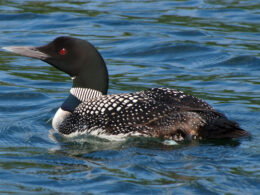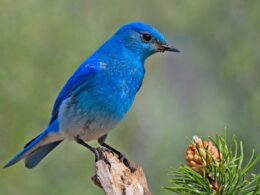Last Updated on January 24, 2024 by Greg Gillson
Winter is here! Are you ready to feed the winter birds in Louisiana?
Do you need some new ideas on what different foods and feeders will work best to attract birds in winter?
Would you like to learn the names and identification and see some photos of the common birds in winter at your feeder in Louisiana?
If so, this article is for you!
This article tells why and how to set up a bird feeder in Louisiana in the winter. I’ll also show you photos of the common feeder birds in Louisiana that you can look for at your own backyard feeder! I will give brief identification tips. I will tell you what foods and what type of feeders attract each species.
Why feed winter birds in Louisiana?
Winters in Louisiana are fairly mild. Most days are well above freezing for a high temperature. Natural foods abound.
Thus, birds don’t really need us to feed them in order to survive.
Rather, feeding birds in Louisiana is all about enjoying nature and bringing living things into our lives and backyards. We feed birds because it brings us joy.
And the extra food birds find in our feeders make sure that they aren’t overly stressed in winter. Birds get plenty of stress with severe weather, loss of habitat, or predators. So having the safe haven of our yards can help them do better.
Many birds in our backyard may be migrants. They need to fatten up in the spring for their long northward migration. So having ample food during late winter can be a help.
Watching birds can be a private or social pastime. Many people enjoy discussing with their friends and neighbors the latest birds to visit their feeders and their unusual antics.
What birds come to feeders in winter in Louisiana?
There are two broad categories of birds visiting your feeders in winter. There are the year-round residents. There are the winter visitors that spend the summers farther north.
Once you learn the common year-round birds, you’ll quickly notice an unusual visitor.
Watching the seasons change with the coming and goings of birds keeps us connected to nature.
You can watch birds without learning their names. But learning to identify the various species brings a special intimacy with the birds, I think.
If you are interested in the birds in your backyard throughout the year (not just winter), and some that do not regularly visit feeders, then you may like my article Backyard birds of Louisiana. I’ll link to this resource again at the end of this article.
Here, then are the birds that are most likely to show up at your feeders in Louisiana in winter.
Northern Cardinal
These are well-known birds due to their bright red coloration, fairly large size, and perky crest.
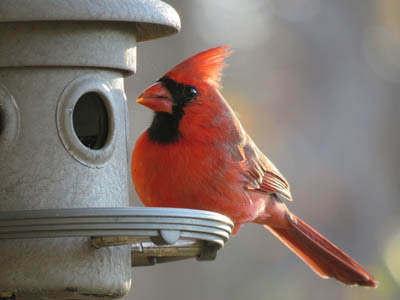 |
| Northern Cardinal. GeorgeB2 from Pixabay. |
These are year-round residents throughout the East and South.
Northern Cardinals are year-round residents throughout Louisiana.
Larger than sparrows, but smaller than robins. Males are bright red, females brown. They have thick orange bills, black chin and throat, and obvious crests.
Northern Cardinals eat larger seeds, including sunflower seeds and safflower seeds from hopper and platform feeders, but often feed on the ground.
Yellow-rumped Warbler
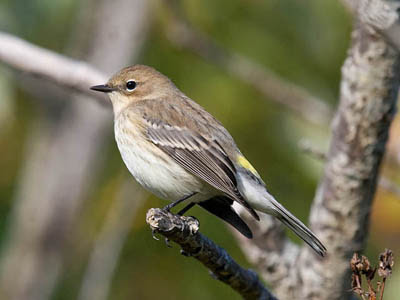 |
| Yellow-rumped Warbler Photo by Greg Gillson |
Yellow-rumped Warblers are winter visitors throughout Louisiana.
These abundant warblers nest in conifer and mixed forests across Alaska and Canada and in the mountains of the northeastern United States and the West. They winter along both Atlantic and Pacific coasts of the Unites States and across the southern states into Mexico.
In summer they are very bright. The upper parts are bluish and they have a black chest. They have a yellow crown patch. Western birds have a yellow throat and large white wing patch. Eastern birds have white throat and two white wing bars.
In winter they are very dull. But, summer or winter, they flash white tail corners in flight and have a bright yellow rump.
They have a complicated slow warble ending in a trill. Their call note is a flat tchep.
While you may see Yellow-rumped Warblers crawling through leafy foliage gleaning insects, or flying out to snatch bugs out of the air, they will come to your feeder if you offer suet.
Blue Jay
These are well-known birds, displayed in advertising and sports teams.
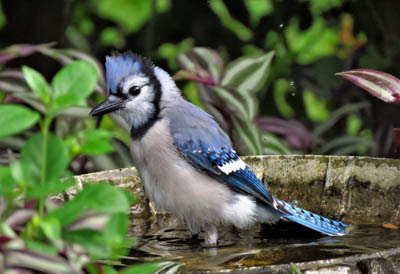 |
| Blue Jay. Skeeze from Pixabay. |
They live year-round in deciduous woods with oaks or nuts through most of the United States east of the Rocky Mountains. In summer they also migrate north well into Canada.
Blue Jays are year-round residents throughout Louisiana.
These are blue above, white below and on the face, with a black necklace across the throat wrapping behind the head. The blue crest is a distinguishing mark.
Blue Jays eat sunflower seeds. They love peanuts, too. They use hopper and platform feeders.
Mourning Dove
These birds are one of the most widespread in North America.
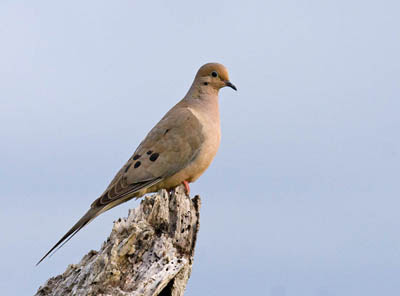 |
| Mourning Dove. Greg Gillson. |
In summer they breed in open fields, farms, prairies, towns, across all of the United States and north into Canada. In winter they depart most of Canada and the northern Great Plains and higher elevations in the northern states.
Mourning Doves are year-round residents throughout Louisiana.
These plump birds have a small round head and pointed tail. They are larger than most feeder birds, but not as large as a domestic pigeon.
Mourning Doves eat mixed seeds and grains. They prefer eating on the ground or from platform feeders.
Carolina Chickadee
This cute little bird is widespread throughout the southeastern United States in deciduous forests.
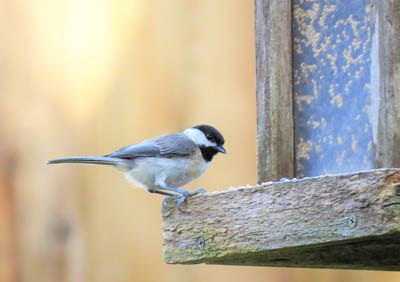 |
| Carolina Chickadee Image by George2 from Pixabay |
Carolina Chickadees are year-round residents throughout Louisiana.
They give a rapid chick-a-dee-dee-dee call and a whistled song fee-bee, fee-bay.
Gray back, wings, tail, and pale gray flanks. Black cap and throat contrasting with white face.
Carolina Chickadees like seeds, especially black oil sunflower seeds. They like suet, too. They eat from any kind of feeder.
Carolina Wren
This wren is a common resident in woodland tangles and backyards throughout the East.
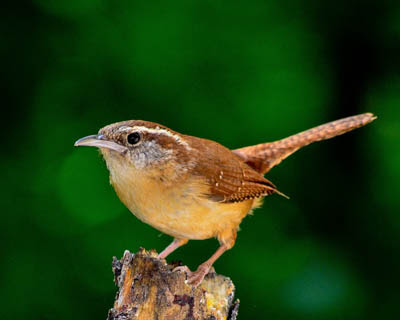 |
| Carolina Wren Image by SOARnet from Pixabay |
Carolina Wrens are year-round residents throughout Louisiana.
They sing all year, a loud musical teakettle, teakettle, teakettle or cheery cheery cheery. The call notes are loud and varied, including a chert call.
These have typical round wren bodies with short neck and long active tails. They are rich brown above, warm buffy below with a white throat and long white eyebrow strip back from the eye.
Carolina Wrens visit suet feeders.
Red-bellied Woodpecker
These woodpeckers are fairly common at bird feeders in the East, especially where there are larger hardwood trees.
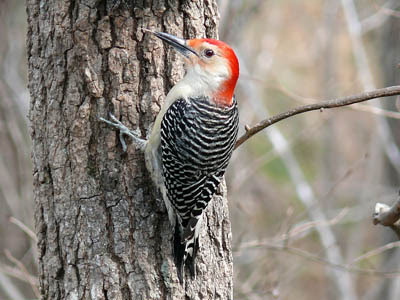 |
| Red-bellied Woodpecker. Skeeze from Pixabay. |
These birds live year-round in the United States east of the Rocky Mountains and Great Plains.
Red-bellied Woodpeckers are year-round residents throughout Louisiana.
These birds cling to tree trunks. They have finely barred black-and-white backs. The head and under parts are rather pale gray. Red feathers on the back of the neck reach the bill on males.
Red-bellied Woodpeckers love peanuts from platform feeders. They also eat sunflower seeds and suet.
American Goldfinch
This bright yellow-and-black bird is a favorite summer bird. However, many people don’t recognize these birds at their feeders in their dull brown winter plumage.
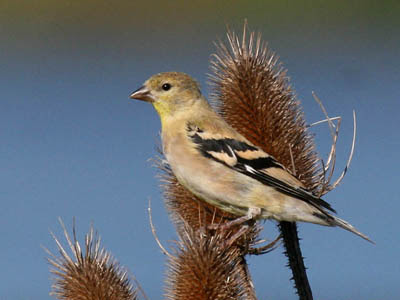 |
| American Goldfinch. Greg Gillson. |
Year-round residents across the northern half of the United States. In summer birds breed north well into Canada. In winter they move south throughout most of the U.S.
American Goldfinches are year-round residents in northern Louisiana, winter visitors throughout.
These are tiny birds with short forked black tails. Wings are black. Winter birds are dull brownish. In summer females are green while males are brilliant lemon yellow with black cap.
American Goldfinches eat black oil sunflower seeds from tube feeders. They love Niger seed from thistle feeders.
White-throated Sparrow
These birds are fairly common in the East in winter, rather rare throughout the West.
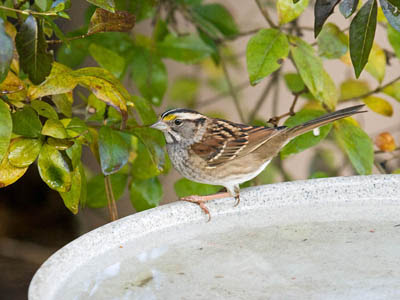 |
| White-throated Sparrow. Greg Gillson. |
These birds breed in Canada and northeastern United States. In winter they occur in the eastern and southern U.S.
White-throated Sparrows are winter visitors throughout Louisiana.
These fairly large brown and gray sparrows have a striped head. The head striping can be gray and tan or black and white. The obvious white throat is bordered on the sides with throat stripes and contrasts strongly with the gray breast.
White-throated Sparrows eat smaller seeds such as white proso millet found in better mixed seed brands. They prefer to eat on the ground or platform feeders, but will also use hopper feeders.
Downy Woodpecker
This small woodpecker is widespread in North America and fairly common at bird feeders in winter.
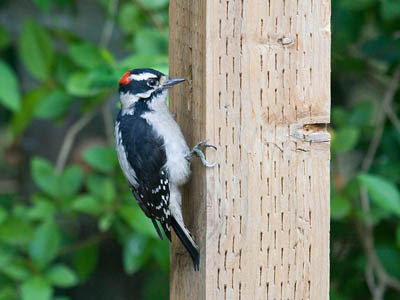 |
| Downy Woodpecker. Greg Gillson. |
Year-round residents from Alaska and across Canada south through the United States, but absent from the Desert Southwest.
Downy Woodpeckers are year-round residents throughout Louisiana.
These are less than 7 inches long, bill tip to tail tip. They have a black and white striped head, white back, and black wings with white spots.
Downy Woodpeckers love suet from suet feeders. They also eat hulled sunflower seeds.
Tufted Titmouse
These plain birds are rather common at bird feeders in the East.
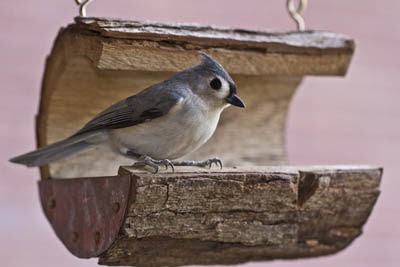 |
| Tufted Titmouse. Anne773 from Pixabay. |
These birds live year-round in deciduous woods east of the Great Plains in the United States.
Tufted Titmouses are year-round residents throughout Louisiana.
Small, a bit larger than chickadees. They are plain gray with a bit of black feathers on their forehead. The crest is often inconspicuous.
Tufted Titmouses eat black oil sunflower seeds from hopper feeders. They are also fond of peanuts.
Eastern Bluebird
If you have some open farmlands adjacent to your home, you may attract Eastern Bluebirds to your backyard. If so, you’ll want to set up some bird houses in summer.
 |
| Eastern Bluebird. Image by skeeze from Pixabay. |
These birds are found in orchards adjacent to open fields and pastures. They may be found in open pine forests and parks. They are year-round residents in North Carolina.
Eastern Bluebirds are year-round residents throughout Louisiana.
Bluebirds are pudgy and a bit larger than House Finches or sparrows. They have a large head and short bill. The tail is rather short. They are blue above with rusty orange on the throat and across the breast.
Their call is a mellow rising chur-lee.
They hunt insects by perching quietly on a fence or low tree branch, then dropping on them on the ground. You can attract Eastern Bluebirds to your platform feeder by offering a dish of fruit, such as raisins, blueberries, cranberries, orange slices, and cherries. They also love mealworms. They love bird baths, too.
House Sparrow
These are common city birds in noisy messy flocks.
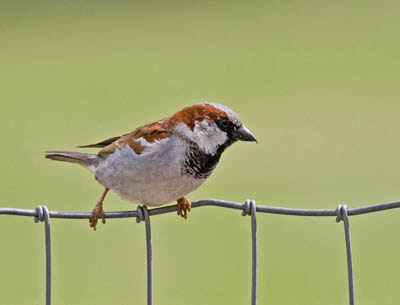 |
| House Sparrow. Greg Gillson. |
Found throughout much of Canada and the United States, wherever there are people and towns.
House Sparrows are year-round residents throughout Louisiana.
Small squatty flat-headed sparrows. Females are rather brown and tan with a pale broad eyebrow, and plain breast without streaking. Males are more chestnut brown above with white wing bars, gray below, with gray crown and black chin, more extensive in summer.
House Sparrows eat a wide variety of small seeds and human food scraps from hopper and platform feeders, and also the ground.
Pine Warbler
Most insect-eating warblers don’t visit feeders. But this species is the exception!
 |
| Pine Warbler. Nikolaus Schultz, Pixabay. |
These birds spend the summer in the eastern United States and adjacent southern Canada. Northern birds move south for the winter to join their kin that live in the Gulf and South Atlantic States.
Pine Warblers are year-round residents at the edge of the state in the northwest and southeast parts of Louisiana. Birds winter throughout the state.
These are small yellow birds with thin pointed bills. They have olive upper parts and face, yellow throat and breast. They have a white belly and under tail. They sport two white wing bars.
Pine Warblers in winter eat suet and sunflower seeds!
Northern Flicker
These larger ant-eating woodpeckers may often be spotted feeding on the ground.
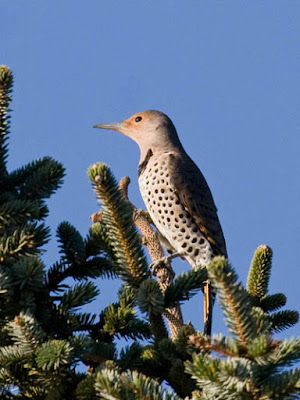 |
| Northern (Yellow-shafted) Flicker. Greg Gillson. |
In summer they range from Alaska and across Canada through most of the United States except the deserts. In winter they are found across the lower 48 states, including the deserts.
Northern Flickers are year-round residents throughout Louisiana.
These are bigger birds than robins with long slightly curved bill and short pointed tail. Their backs are barred black and brown. The pink underparts are full of round black spots. A white rump shows when flying away. Birds in the East (Yellow-shafted) have yellow wing and tail feathers; those in the West (Red-shafted) have salmon-red wing and tail feathers.
Northern Flickers eat suet from suet feeders. They also like nuts and peanuts.
Setting up a winter bird feeding station in Louisiana
The first type of feeder I’d recommend for winter bird feeding in Louisiana is a suet feeder.
Suet will appeal to the woodpeckers: Red-bellied Woodpecker, Downy Woodpecker, and Northern Flicker. Some of the hardy insect eaters will eat suet, too: Yellow-rumped Warbler, Pine Warbler, Carolina Wren. The Carolina Chickadee and Tufted Titmouse will also enjoy suet.
To keep out the over-eating jays, grackles and starlings, though, I’d recommend an upside-down suet feeder. The one I own is the Nature’s Way brand. I haven’t experimented too much with various types of suet. A brand I purchase is rather inexpensive compared to others. It is the St. Albans Bay suet.
The second type of feeder I’d recommend for the common Louisiana winter feeder birds is a hopper feeder. This type of feeder allows mixed seeds and all types of birds to eat from it. Here is a good one from Woodlink that should last many winters.
I really recommend the Wagner’s Songbird Supreme as the best mixed bird seed to use with a hopper feeder. It is over 50% sunflower seeds (whole and kernels) and has lots of white proso millet. Best, it doesn’t have any red milo or any cheap fillers. Birds don’t throw undesirable seeds on the ground-because they love it all!
This mixed seed will appeal to Northern Cardinal, White-throated Sparrow, Tufted Titmouse, Carolina Chickadee, American Goldfinch, House Sparrow, Mourning Dove, and Red-bellied Woodpecker.
Wrapping Up
Winter brings diverse experiences for different types of winter birds in Louisiana, depending on their specific needs and adaptations:
Resident Birds:
- Thrive: Many resident birds like cardinals, chickadees, and titmice are well-adapted to Louisiana’s mild winters and find ample food and shelter throughout the season. They may even benefit from the reduced competition for resources compared to summer.
- Challenges: Colder spells and freezing temperatures can still pose challenges, limiting food availability and requiring extra energy expenditure to stay warm.
Migratory Birds:
- Arrive: Louisiana serves as a wintering ground for numerous bird species escaping colder climates north. Ducks, geese, swans, and sparrows are some common winter visitors seeking warmer temperatures and abundant food sources.
- Adaptation: These birds rely on Louisiana’s diverse habitats, including wetlands, forests, and agricultural fields, to meet their needs. Some may face competition from resident birds or challenges due to habitat loss or weather extremes.
Specifics:
- Wetland birds: Ducks, geese, and wading birds like herons and egrets find ample food and open water in Louisiana’s extensive wetlands, making it a crucial wintering area.
- Woodland birds: Chickadees, nuthatches, and kinglets benefit from Louisiana’s mature forests and wooded areas, where they can forage for insects and seeds.
- Grassland birds: Sparrows and buntings find suitable habitat in fields, meadows, and prairies, where they can find seeds and insects for sustenance.
Frequently Asked Questions
Do birds migrate from Louisiana?
Yes, many birds migrate from Louisiana. The state sits along the Mississippi Flyway, a major north-south migration route for birds in North America. In fact, millions of birds pass through Louisiana each year on their way to breeding grounds in the north or wintering grounds in the south.
Here are some of the birds that migrate from Louisiana:
- Warblers: More than 30 species of warblers migrate through Louisiana, including the colorful Yellow Warbler, the elusive Blackpoll Warbler, and the stunning Prothonotary Warbler.
- Tanagers: Scarlet Tanagers and Summer Tanagers breed in Louisiana’s forests but migrate south to Central and South America for the winter.
- Hummingbirds: Ruby-throated Hummingbirds are the only hummingbird species that breeds in Louisiana, and they migrate all the way to Central America for the winter.
- Shorebirds: Sandpipers, plovers, and other shorebirds use Louisiana’s coastal wetlands as a stopover point on their long migrations between the Arctic and South America.
- Waterfowl: Ducks, geese, and swans migrate through Louisiana in large numbers, using the state’s lakes, rivers, and marshes as resting and feeding grounds.
The timing of bird migration varies depending on the species, but most birds migrate in the spring and fall. Spring migration typically occurs from March to May, while fall migration occurs from August to November.
There are a number of factors that trigger bird migration, including changes in day length, temperature, and food availability. Birds use a variety of cues to navigate their long journeys, including the stars, the Earth’s magnetic field, and the sun.
Bird migration is an amazing natural phenomenon that has been happening for millions of years. It is a testament to the incredible adaptability and resilience of birds.
Where can I see roseate spoonbills in Louisiana?
Roseate spoonbills are beautiful and fascinating wading birds with their distinctive pink plumage and wide, spoon-shaped bills. You have several options for spotting them in Louisiana:
Coastal Louisiana:
- Avery Island: Home to Jungle Gardens, a bird sanctuary known for its large roseate spoonbill colony. Guided tours and elevated boardwalk trails offer excellent opportunities to observe them nesting and feeding.
- Cameron Prairie National Wildlife Refuge: A vast marsh complex providing crucial habitat for spoonbills and other waterbirds. Boat tours and observation platforms offer good chances of sightings.
- Sabine National Wildlife Refuge: Located in southwest Louisiana, it offers diverse habitats with marshes, ponds, and woodlands attracting spoonbills along with other shorebirds and waterfowl.
- Grand Isle: This barrier island at the southern tip of Louisiana is a popular spot for birders, offering good chances of seeing spoonbills feeding in the shallow waters around the island.
Other Potential Locations:
- Lake Pontchartrain: Some spoonbills might be spotted in coastal areas around the lake, particularly in marshes and bayous.
- Vermilion Bay: The Vermilion Birding Loop includes coastal areas and islands where spoonbills can occasionally be seen.
Related Articles:
The most common backyard birds in Louisiana
My recommended bird feeder setup
Bird seeds that attract the most birds
Different kinds of bird feeders for different birds
Bird baths that birds actually use









